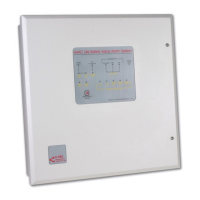A
VAC VOICE ALARM SYSTEM
AVAC Installation and Maintenance Manual • Approved Document No. DAU0000402 Rev 6 • Page 8
Monitoring
In order to comply with British and European life safety standards, AVAC’s loudspeaker lines, PSU,
batteries, emergency microphone and digital message store are all monitored for short circuits,
open circuits, earth faults, discharge, disconnection and data corruption as appropriate.
Non-critical inputs such as public address paging and background music are not monitored and, in
the event of mains failure, are automatically cut off to conserve battery life. This contributes to
the AVAC’s extremely efficient standby time - typically 24 hours (plus 30 minutes running) using
2 x 7 A Hr VRLA batteries.
Provided the system is wired as detailed in this manual, a fault condition will be reported as a
sounder fault on the fire detection system to which it is connected, with more detailed fault indi-
cation provided on the front of the AVAC.
Digital message selection
All digital messages are stored in MP3 format on a monitored, non-volatile memory card that
plugs directly onto the Main PCB.
The content of these messages can be adjusted to suit the application using a series of internal
links. For example, the Evacuate message can be configured to state that ‘a situation has arisen’
or ‘a fire has been reported’ and to warn people - if appropriate - not to use the building’s lifts.
Amplifier and speaker circuits
AVAC is supplied with a minimum of two separate 60 watt Class D amplifiers (A and B). These are
designed to drive two loudspeaker circuits, each of which will accommodate up to 60 watts of
loudspeaker load, through 100 V line transformers, which step up the voltage for distribution
around the site.
An end of line device must be connected across the terminals of the last loudspeaker on each
circuit and both circuits must be calibrated at commissioning using the calibrate button to ensure
correct monitoring.
Some AVACs feature an additional ‘hot-swap’ standby amplifier that will switch in if either of the
regular amplifiers (A or B) fail, a requirement of some life safety voice alarm specifications.
Multiple A
V
ACs and slave amplifiers
There is no limit to the number of master AVACs that can be used per system. Please note
however that the VA405 emergency microphone can be daisychained to a maximum of
10 masters only.
T
o incr
ease audio coverage in ar
eas such as war
ehouses, etc., up to 10 slave A
VACs can be
connected to one master.
Slaves r
epeat all emer
gency microphone and digital message broadcasts that are made at the
master to which they are connected. They also feature their own paging and BGM inputs.
Therefore, if multiple masters and/or slaves are used, localised paging and background music can
be easily implemented.
www.acornfiresecurity.com
www.acornfiresecurity.com

